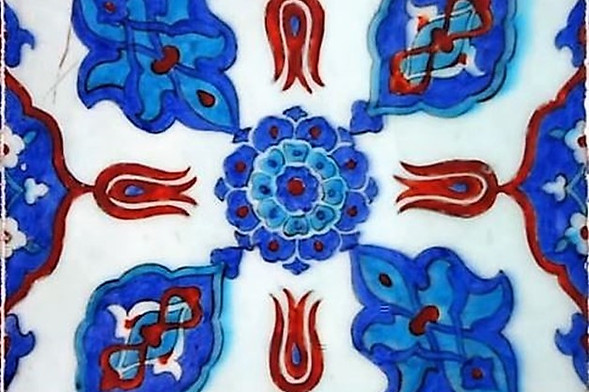

Background
Journey of the Tulip from Asia to Europe in Visual Arts

Tulips originate from the Tian Shan Mountains in Central Asia. It is not documented when the first cultivation of tulips started, but it is known that around 1050 they were already very popular with visitors to the gardens of Isfahan in Persia, as well as in Baghdad, Iraq. These tulips had narrower petals and were much shorter than modern tulips.
They were predominantly blood red and were revered by the tribes inhabiting this area. The flower was named 'lale', which comes from the word 'lal' and means red. The tulip then made its way to Turkey via the Silk Road and became the symbol of the Ottoman Empire. When the lale entered the West, it became a status symbol for the European elite, not only because of its colors and variability, but also because of its exotic resemblance to 'the headdress of a Turkish man', the turban, after which the tulip was eventually named.

The Ottoman Love of the Tulip - Levni (1680s-1732)
The tulip on Iznik tiles
The famous Rustem Pasha Mosque was built around 1560, named after one of the best-known Ottoman statesmen of the time, and designed by architect Mimar Sinan. The mosque is located in the historical heart of Istanbul and is famous for its decoration with the most beautiful tiles from the Ottoman period. Forty one different tiles with tulip motifs can be seen throughout the mosque. The tiles were made by artists from Iznik.
Below are three examples of Iznik tiles with a tulip motif from the 16th century in the Rustem Pasha Mosque in Istanbul, Turkey.



The tulip has been a common motif in Ottoman and Turkish designs for centuries. It is used in textiles, tiles, ceramics, architecture and calligraphy art. Fortunately, some works of craftsmen from many centuries ago have been preserved. Below are a few examples:

Ottoman painting on wood from the 16th century, and on the right a fragment from a 17th century kemha. Kemha is a textile made of silk and yarn wrapped with metal.
Sultans used kaftan robes as symbols of power. So it's no wonder a lot of pattern and decoration was applied to it. The whole Kaftan was cut extra long and wide to make a sultan look even more majestic. This is the portrait of Sultan Selim II (1512-1520) practicing archery. The miniature painting dates from the 1560s and is the work of the famous painter Nigari. The sultan wears a kaftan with a design of tulips and small red flowers in a medallion pattern, on top of a robe with a floral design.

The discovery of the tulip in Europe
The Fleming Ogier Ghiselin de Busbecq, who traveled to Constantinople (Istanbul) as an ambassador in 1558, believed he was the first to discover the tulip. He writes about his discovery in a book in 1581.
But perhaps it was the Swiss naturalist Conrad Gesnner who introduced the tulip to Europe when he saw the flower in the garden of the Augsburg magistrate Johann Heinreich Herwart in 1559. He drew the special flower and made notes about it. His drawing is seen as the first depiction of a tulip in Europe.

First image of the tulip in Europe - Conrad Gesner (1516-1565)
The introduction of the tulip to the Netherlands
It was the Flemish botanist Carolus Clusius (1526-1609), who brought the tulip to the Hortus Botanicus in Leiden, the first and now oldest academic garden in the Netherlands. Clusius closely observed the growth and flowering of tulips and was especially fascinated by the varieties with multicolored and feathery petals. See the image below of the Semper Augustus from that time.

17th century - Semper Augustus, the most expensive tulip during the Tulip Mania
Tulip mania
Between 1633-1637, these striking tulips were so popular that the price of the bulbs rose rapidly and investors paid exceptionally high prices, sometimes as much as ten times the annual salary of a craftsman. This led to an extraordinary episode of price inflation known as Tulip Mania, also known as tulip wind trade. Tulip Mania is seen as the first financial bubble that burst around 1637. In the painting below, a nobleman guards the tulip fields in bloom, while soldiers trample flower beds in a vain attempt to stabilize the tulip market by limiting supply.






